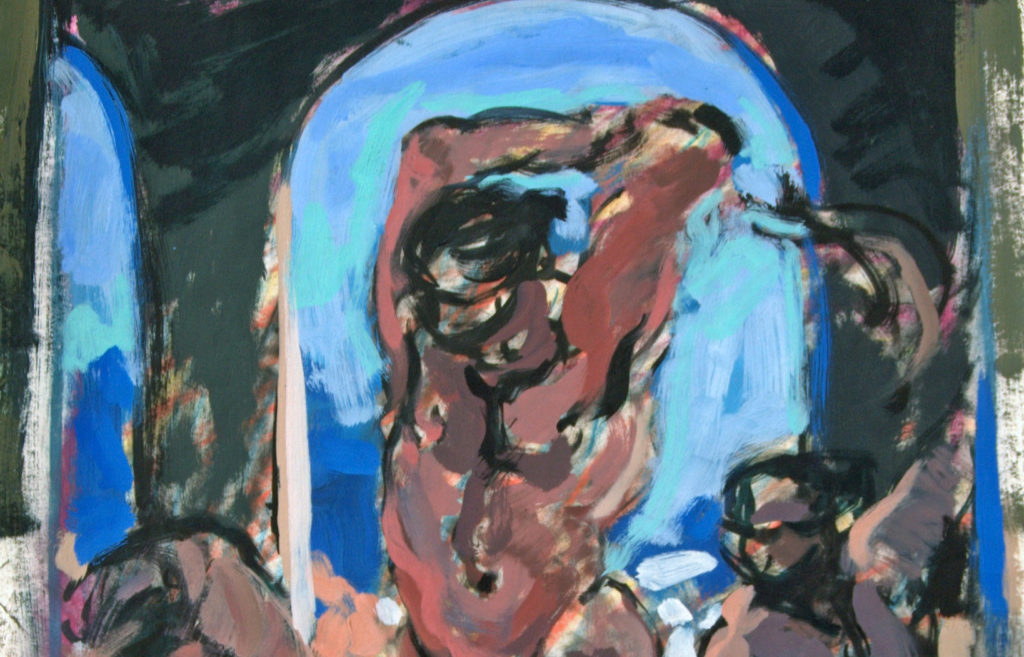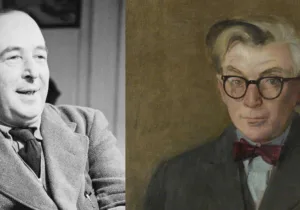In its splendor, the second temple in Jerusalem that Jesus would have seen was far more magnificent than the more modest edifice—however miraculous in provenance—constructed by those Jewish exiles whose return to Jerusalem from Babylon is retold in the closing chapters of Second Chronicles and in Ezra and Nehemiah. The temple of Jesus’ day was one element of a reconstruction plan of astonishing ambition undertaken by Herod the Great, the polarizing—at least some think his monstrous rule was offset by positives—client king of Rome. Herod’s expansion of the temple wasn’t exactly a study in pious magnanimity. Rather, he wanted to possess a capital city worthy, as he said, of his own “dignity and grandeur.” Apparently the significance of even the modest temple being the dwelling place of God was lost on him.
In any case, the building project and completed structure were by all accounts extraordinary. The engineering marvels began with the massive expansion of the Temple Mount itself, which was more than doubled in area from seven to fourteen-and-half hectares, or about thirty-five acres. Of the completed temple complex, it was said in the ancient world that if you had not seen the Temple of Herod then you had never truly seen a beautiful building.
Set within an array of courts and structures, the holy place or sanctuary, within which was the Holy of Holies, formed the heart of the Court of the Priests. Here, with the altar and butchering place, the conflicting odors of the sacred and profane would have clashed into a marbled thing of incense, roasting flesh, and the humid-iron scent of slaughtered animals. From there, three additional courts extended out toward the entry. Israelite men could enter the court nearest the Court of the Priests. Israelite men and women together could occupy the next, much larger, court. Known as the Court of the Women, the bulk of New Testament stories described as taking place within the temple area would have happened here. Beyond this, was the Court of the Gentiles, the largest court of all and the only place non-Jews could come. By design they came in order to pray to the God of Israel. It did not always work out this way and, for this reason, it is here that a great drama observed on the Monday of Holy Week occurred.
From near and far, first-century Jews came to the temple at Passover to sacrifice to the Lord. Impractical as it was to travel significant distances with sacrificial animals, provision was made to allow their acquisition in Jerusalem. Enterprising vendors set up shop in the Court of the Gentiles. The court was filled with merchants selling animals to worshippers and money changers who exchanged Roman coins for shekels that had no image of the emperor on them and thus were fit for payment of the temple tax. Giving us some sense of the scale of the operation, the first-century historian Josephus reports that a quarter-million lambs alone might be sacrificed during the Passover. Exorbitant sums would sometimes be charged for both animals and exchange rates, placing additionally gratuitous burdens on the poor. Because of the activity and the crush of stalls, creatures, and humanity, anyone with any intention of praying in the court would have found the prospect, well, a beast of a challenge. Whether by simple disregard or by design, the merchants, and the temple authorities who allowed their activities, seemed to care nothing for the unhindered worship of neither the destitute Jew nor the devoted gentile. The Messiah wasn’t good with any of this.
Then Jesus entered the temple and drove out all who were selling and buying in the temple, and he overturned the tables of the money changers and the seats of those who sold doves. He said to them, “It is written, “My house shall be called a house of prayer; but you making it a den of robbers.”

The concerns at play in the temple cleansing are multiple. Among them, the sheer chutzpah of Jesus claiming the authority to judge and purify the activities in the temple would presumably have shocked those who witnessed it. A clear proclamation of messianic purpose, Jesus’ actions would have confirmed the opposition of the Sanhedrin against him. Christ’s demands for pure worship, for the unimpeded witness of the people of God to the gentile world, and for the care of the poor would all have been motivating factors in his kinetic zeal.
I don’t (quite) want to suggest that the temple cleansing can also provide the Christian with any kind of comprehensive statement on the use of force. It doesn’t. But this isn’t to say that nothing on the subject can be gleamed from it. At the risk of making too much out of very little, I want to ruminate on a few things.
First, while it might describe another, earlier, temple clearing, the version of the event written about in the Book of John provides a few interesting details not described in the synoptic gospels:
The Passover of the Jews was at hand, and Jesus went up to Jerusalem. In the temple he found those who were selling oxen and sheep and pigeons, and the money-changers sitting there. And making a whip of cords, he drove them all out of the temple, with the sheep and oxen. And he poured out the coins of the money-changers and overturned their tables. And he told those who sold the pigeons, “Take these things away; do not make my Father’s house a house of trade.” His disciples remembered that it was written, “Zeal for your house will consume me.”
Possibly, the fact that Jesus took the time to make a whip of cords suggests at least some level of premeditation that dismisses any notion of a purely spontaneous act. While no one should imagine the Messiah at risk of flying off the handle, and while the assembly of a whip made of cords might have been a simple and crude design, the obviously intentional use of force is notable. Excursus: if I were I were to film the scene, I’d have Jesus sit in the midst of the throng with his cords and braid the thing—at least a handle—all the while casting his eyes over the obscenities around him and visibly growing in (controlled) wrath. While I’m not going to pretend that we have here a gospel-based argument in favor of a military industrial complex, I only want to emphasize that the Christian use of force is characterized by deliberation, preparation, and control. If it’s right to use necessary, proportionate, and discriminate force, in the last resort, when nothing else is likely to successfully defend the innocent, right wrongs, or punish evil, then it is also right to build the capacities—including materiel, training, and virtue—to do so.
These values are also suggested in the discrimination Jesus displays. It’s interesting that in the midst of the overturning tables and whipping, he takes a minute to tell those selling the pigeons to “take these things away.” Now, again, this might be making much of out nothing, but while he drove out the sheep and oxen, he does not shatter the cages that contain the birds. Why? I’ve heard it suggested that whereas it would be a relatively easy matter to recover a stock of sheep or cattle, the recovery of lost birds would have been another matter. Perhaps it was not so much the selling of the animals that was the problem—the provision of sacrificial animals presumably was a genuinely valued service. If Jesus’ anger was focused more on the manner of or intent behind the sales and the fact that they inhibited gentile worship, perhaps he did not want to disproportionality harm the dove sellers or overly-handicap the ability to purchase them. By telling them to grab their stock and leave, Jesus perhaps purposefully avoided destroying both their own source of income and their ability to render needed services—especially because the doves would have been all the very poor could have afforded.
But what I find most reassuring in the whole temple-clearing narrative, is the simple and obvious fact that we worship a God who is willing to overturn tables when tables need to be overturned and who knows that the controlled application of force is sometimes necessary to protect the innocent and to vindicate justice and to punish wrongdoing. The presence of a similar understanding among those who worship that God is not always quite so obvious. We too often fail to be properly angry at sufficiently gross injustices so as to be moved to action, or we allow our anger to boil over into uncontrollable rage and do cause destruction than restoration.
Another excursus: I wrestled with my kids throughout their early childhood (and sometimes still). By the time my daughter was a scrappy seven, she had pretty well mastered the tactic of punching for the solar plexus. On more than one occasion, I started to wonder whether I’d over-taught her. By the time my son was eleven, he was really making me work hard at not getting maimed or permanently disabled. Apparently as boys grow, they start pumping all kinds of bio-chemical cocktails through their bodies that result in things like muscle, the capacity for efficacious aggression, and a healthy dose of cocksuredness that would humble Han Solo. That I considered then, and consider, now all of this absolutely fantastic is a problem for some.
I once heard a sermon about the third chapter of Colossians in which husbands are commanded to love their wives and to “not be harsh with them.” Somewhat oddly, the preacher’s message focused on the idea that husbands shouldn’t use their physical strength to threaten or intimidate their wives—neither willfully nor unintentionally. Fair enough; and taken in itself there’s really nothing there to complain about. It’s what wasn’t said that bothered me. The preacher said nothing about the better purposes for which the husband’s physical strength might be rightly employed. He said nothing about the protection and defense of the family or the greater good of the surrounding community or nation. I imagined what my son—thankfully tucked away in Sunday school and safely protected from the pulpit—might have picked up from the message had he been sitting with me. Just beginning to become aware of his own growing strength and strength’s potential, he would have learned only that a man’s strength is something to be feared and stowed away. He would have been unintentionally deprived of both the great things that the Hebraic tradition has to say about power and its uses and of the great joy he could take in the tradition saying so. God did not create men with muscles only to tell them to mortify their ambitions to use them—he created them to use their strength properly. Why did the pastor not expound on that? That would have been a sermon worth hearing.
Instead, from the pulpit to the classroom and everywhere else, boys, we too-often hear it said—implicitly or explicitly—are problems. This once caught me flat footed. When I first heard the phrase “toxic masculinity” I assumed it was a clever bit of sarcastic snark coined to mock those few who sincerely seemed to think boys are weapons of mass destruction that pose existential threats to humanity unless they are gelded. But, of course, I was wrong.
An essay a few years back at The Federalist—an excellent reflection about raising boys to be ready for war—turned my attention to a series of less-excellent articles posted at The Cut, a magazine for women “with stylish minds” intersecting the focal categories of “Style, Self, Culture, and Power”. The series is all about how to raise boys. It’s a fascinating series, mostly because it’s a primer on how people I really disagree with think about a subject of not just personal passion but that resonates with the charter of Providence as well. The series was written as a response to the #metoo movement, the Parkland shootings, and, well, Donald Trump. There’s a desperate honesty in the pieces, they really do think everything is at stake in how we raise our boys.
Of course, on that point we are in agreement. There’s a wonderful anecdote that I’ve retold many times that was originally told in the conclusion of When Character Was King, Peggy Noonan’s biography of Ronald Reagan. She tells of the time when one of the staffers was walking his three-year-old son through the halls of the White House. The boy had brought with him a plastic sword—which, it occurs to me now, might never be allowed past security these days. But, as Noonan tells it, back then at one point in the tour of the hallway a secret service agent stopped the little boy and playfully inquired, “What’s the sword for?” Without missing a beat, the little man said, “I want to fight bad men.” Noonan approves the zealous sentiment. She reflects:
The little bodies of children are the repositories of the greatness of a future age. And they must be encouraged, must eat from the tales of those who’ve gone before, and brandished their swords, and slayed their dragons.
That children are constantly being encouraged in any way isn’t, of course, the problem. The problem is that they are not being encouraged toward the good things of Noonan’s prescription. In one of the essays at The Cut, the writer Will Leitch appears to want his sons to know that this world “is a zero-sum game.” He laments his own “aggressiveness and entitlement” by which he means the advice he’s given to his children “to be whatever they want.” This advice, he insists, has been “weaponized over the generations” and comes “at a cost, someone else’s cost.” He explains:
This lesson of self-reliance is not only an illusion, it brings with it its own privilege. I can tell myself that any “success” I’ve had has been because of “hard work” and “perseverance,” but I’m kidding myself. I’m a middle-class white kid who was encouraged to go his own way, to be his own person, in a way nobody even bothered to question; being America’s default on the form meant I was never expected to stand in or up for anything other than myself.
I do not know the America this guy grew up in. When I was a child, no significant authority figure in my life—I’d be hard-pressed to think of any authority figure at all—ever told me the American default was to fight for yourself and no one else. The most relevant men—and women—in my life would have pounded me into sand if I suggested aloud that looking out for number one was worthy of a life or an appropriate philosophy for jus ad vim.
The America I grew up in was formed by the consciousness found in the great Westerns. The convention of the genre is usually some take on the necessary—and typically reluctant—use of force in defense of some great good. Often enough, a weary gunslinger enters into a community struggling to become a civilized place of law and order but hamstrung in doing so by the self-serving ambitions of a remorseless villain. The gunslinger, trying to leave behind a life of violence, avoids getting involved until it is made plain that remaining aloof will mean that the innocent will be destroyed by the violent, and that only the application of a greater and more lethal counter-violence will save them. The greatest Westerns do not celebrate the violence. They only celebrate that which the violence defends. Indeed, the greatest Westerns are nothing like carnage-as-entertainment, rather they meditate on the terrible price exacted by even the just deployment of force—not centrally on those who suffer that violence, but on those who necessarily have to deploy it.
My three favorite Westerns, in no particular order, are Once Upon a Time in the West, The Man Who Shot Liberty Valance, and Logan—the 2017 film concluding the Wolverine franchise. If you doubt whether Logan is a Western, read my review and rejoice in being corrected. Germane to our current topic, one of the themes of Logan, and the particular Westerns that helped inspire it, suggest that violence—force—is not something that most be stowed away in order to prevent reckless harm. Rage, in fact, is something that can be nurtured. A peripatetic virtue that is taken up and clarified in the Hebraic tradition, proper rage can be cultivated. One can learn to be angry at the right things, in the right way, at the right time, to the right degree, and with the right intention. Lit up by that kind anger, one can learn to act accordingly—that is to say justly, with proportion, with discrimination, and for peace. That’s to say, one can learn to be angry in love. Moreover, films such as Logan further insist that this love, too, can—and must—be nurtured. In bringing violence and love together, such films follow the just war tradition’s chivalric grounding. Chivalry molded men into composite beings: ferocious to the nth degree, and gentle to the nth degree—each manifest in its proper time and, in proper proportions sometimes very hard to see, always qualified by the other. I expand on all this in an essay on C.S. Lewis and chivalry, which is a reflection of the characteristics necessary for the cultivation of just warriors—hint: they’re knights! Hint, hint: knights slayed dragons! Indirectly, the essay is a meditation on raising sons for war. Yes, yes, it’s a mediation on raising sons and daughters tout court; but, it’s a particularly salient message for boys struggling to grow up in a gelded culture that no longer seems to know what to do with them.
The cleansing of the temple is one small reminder, among many, that Jesus did not save us from the Old Testament God. To be sure, the cleansing does not render plain a great many complex questions—such as discerning the mind of Christ on war. Questions regarding war and peace conceived as social and political issues were never the specific topic of his ministry. The cleansing does display the Messiah’s concern for justice, mercy, and the love and unfettered worship of God. It ought also to put to rest any question, as the theologian DA Carson puts it, of “God as implacably opposed to us and full of wrath, but somehow mollified by Jesus, who loves us.” It is continually important to recall that themes of extraordinary mercy, grace, gentleness, and unabashed love are found throughout the Old Testament in God’s dealing both with those within and those without his Covenant. Additionally, we must observe the aspects of divine wrath found throughout the New Testament–where even a Savior overturns tables. Regarding the divine response to evil, the Testaments are a continuum, Carson notes:
Both God’s love and God’s wrath are ratcheted up in the move from the old covenant to the new. These themes barrel along through redemptive history, unresolved, until they come to a resounding climax—in the cross. Do you wish to see God’s love? Look at the cross. Do you wish to see God’s wrath? Look at the cross.
And then rejoice in the zeal of our Lord.






